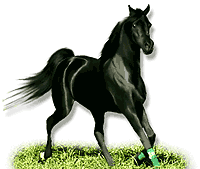Breed: Arabian Horse
Temperament: spirited, intelligent
Lifespan: 25-27 years
Recommended for: experienced horsemen
Arabians are said to be the oldest breed of horse in the world and are admired universally for their spirit, grace and beauty. They are one of the key ancestors of all modern thoroughbreds.
Appearance
Arabians are compact, muscular horses with slender legs and stand between 14-15 hands high although some modern breeding is producing Arabs around 16 hands high. They have an arched neck and a head with characteristic features: eyes large and set wide apart, the forehead is ‘dished’ ie: with a smooth concave line between the eyes and nose, and the nostrils large and open.
Colours range from purest white through chestnut, brown, bay and grey to glossy black. Another Arabian trait is the tail which arches up and over the back when excited.
Within the breed there are lines bred to suit a wide range of equestrian activities ranging from endurance events to led classes, the latter effectively a beauty pageant. This can lead to slight variations in the conformation of individual horses, ie: a cross country horse may be more athletic and lean than a show horse.
Temperament
While Arabians are expected to show spirit, they are said to be human-oriented and adapt to sensitive training techniques. If treated wrongly they can become nervous and flighty. They are classified as a hot-blooded horse as distinct from cold-blooded horses such as draught horses.
Health
Arabs can suffer from more individual diseases than other breeds but most are rare and usually apparent in early life. Problems include melanomas (although most are benign), gastrointestinal problems, and compromised immune systems. Arab Fading Syndrome is typified by the loss of pigment around the eyes and muzzle.
Breeding
Arabians are considered very good breeders with foaling considered desirable between August and December. Twins are uncommon.
Space and feeding
Stabling costs from $25-$150 a week, while feed bills are $20-$30 weekly, although these can vary enormously depending on the level of care demanded.
Ideal owner
Considered by many to be the ultimate horse, Arabians are versatile and suit a wide range of activities. They may not be the best choice for nervous or inexperienced riders unless closely supervised.
Grooming
Regular grooming will not only keep the horse looking nice, but will quickly pick up any minor injuries, skin or hoof problems. Competition and riding horses may need to be shod six-weekly and costs $40-$60.
Popularity
There are around 100,000 Arabians registered in Australia of which just over 40,000 are purebred. Australia is said to be the world’s second-largest breeder of Arabians (USA 1, UK 3).
For further information
NSW/ACT
Ms Anne Garfoot (Secretary)
NSW Arabian Horse Association
PO Box 125
Richmond, NSW, 2753
Phone: 0418 412 871
Alison Hudson (secretary)
Arabian Riders and Breeders Association (ACT and Southern NSW)
GPO Box 1057
Canberra, ACT, 2601
Phone: (02) 6236 9335
QLD
Matt Sheard (secretary)
Arabian Horse Association (QLD) Inc.
PO Box 128
Goodna 4300
07 5465 8445
VIC
Maria Dario
The Victorian Arabian Horse Association
PO Box 30
LONGWARRY 3816
Phone: (03) 5629 5208
SA Mrs Elly Barton (Secretary)
South Australian Arabian Riders and Breeders Society Incorporated
Amberglade Arabians
PO Box 160
Strathalbyn, 5255
Phone: (08) 8536 6177 (fax/ph)
WA
Pets Turland (Secretary)
342 Young Rd
Baldvis 6171
Phone: 0423 908 540
TAS
Melissa Thallin (Secretary)
Tasmanian Arab Riders and Breeders Incorporated
Post Office Box 12
Ravenswood 7250
Phone: 0417137716



